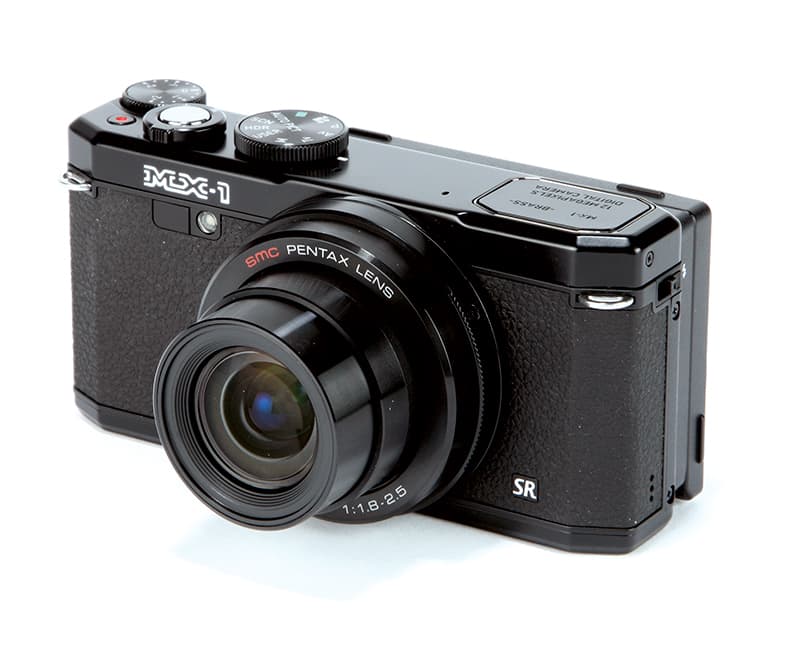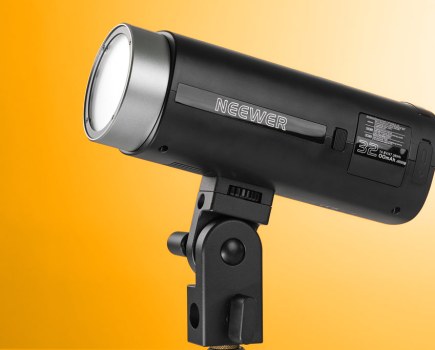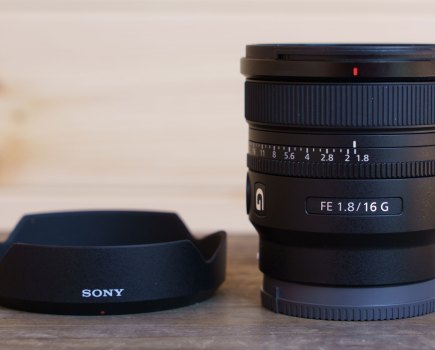Pentax MX-1 at a glance
- 12-million-pixel 1/1.7in CMOS sensor
- 28-112mm f/1.8-2.5 lens
- 3in articulated LCD screen
- Full HD video recording
- Integrated ND filter
- Street price £399
Pentax MX-1 review – Introduction
Pentax may be renowned for its competitively specified DSLRs and a slew of high-quality optics, but up until recently it didn’t appear to show any intention of adding to the pool of enthusiast compacts. Yet now, with the decline in popularity of budget compact cameras, it joins practically every other major manufacturer in providing such a model, one fit to rival the likes of Panasonic’s LX series.
The Pentax MX-1 is in many respects a predictable affair, with a retro styling and a spec list that reads like that from a number of its peers.
With a large sensor, wide-aperture optic and raw shooting, the Pentax MX-1 seems certain to appeal to discerning DSLR owners looking for a lightweight alternative. Yet, with no viewfinder, nor a hotshot in which to place one, it’s likely to polarize opinion.
 Image: Distortion at the wideangle end is unlikely to be deemed objectionable unless the subject is characterised by straight lines or edges. For JPEGs, this can be immediately corrected by the MX-1’s distortion-correction option
Image: Distortion at the wideangle end is unlikely to be deemed objectionable unless the subject is characterised by straight lines or edges. For JPEGs, this can be immediately corrected by the MX-1’s distortion-correction option
Pentax MX-1 – Features
Pentax MX-1 sensor
Most manufacturers have deemed around 12MP as sufficient for their own enthusiast compacts, and Pentax clearly agrees; from a total pixel count of 12.76MP the Pentax MX-1 outputs 12MP images in the 4:3 aspect ratio.
As with sensors inside similar models, it is constructed around a backlit architecture for more efficient light capture, and operates over a broad ISO range of ISO 100-12,800.
Pentax MX-1 formats
In contrast to the company’s DSLRs the Pentax MX-1 provides only one Raw format – namely Adobe’s DNG type, which is instantly compatible with Adobe’s suite of raw-editing programs such as Lightroom and Camera Raw.
Pentax MX-1 video
The Pentax MX-1 is also capable of recording full HD video at 30fps with stereo sound alongside, although there’s no way of attaching an external microphone should you wish to improve on the built-in microphone’s audio quality.
Pentax MX-1 optics
The optic in front of the sensor provides a focal range equivalent to 28-112mm (in 35mm terms), and a respectably wide aperture range of f/1.8-2.5.
Pentax MX-1 ND filter
Pentax follows Canon, Samsung and number of other manufacturers in incorporating a neutral density filter into the camera to prolong exposures, and while shutter speeds as standard stretch from ¼-1/2000sec, enabling the electronic shutter option allows the camera to fire between 30 and 1/8000sec, the latter being particularly beneficial when using wider apertures in bright conditions.
Pentax MX-1 shake reduction system
Pentax’s sensor-based Shake Reduction system is complemented by an optional Pixel Track mode, which calculates blur in an image before attempting to correct it through processing (as opposed to raising the sensitivity, which would introduce more noise).
Pentax MX-1 mode dial
The mode dial, meanwhile, provides access to the standard PASM quartet of exposure options, and also leaves space for a user-defined option. For the less certain, the dial can also be turned to Pentax’s Green Mode, in addition to Auto and Scene settings, and even an HDR option.
Pentax MX-1 menus
Strangely, some features we’d expect to see on such a model – such as control over noise reduction, or a customisable Fn button – are nowhere to be found. Yet, a quick exploration of the menus reveals a surprising level of control offered elsewhere.
The camera can, for example, be set to correct colour casts under tungsten sources either partially or fully, and can also embed copyright information into an image’s metadata. Perhaps most usefully, raw and JPEG versions of an image can be deleted independently of each other, a feature that’s sadly still absent from many other models.

Image: While not capable of ‘true’ macro results, the minimum focusing distance of 1cm still makes images like this possible
Pentax MX-1 review – Build and handling
In the same way that Olympus chose to base the design of its digital Pen offerings on its film models of the same name, Pentax has adopted the design of its MX film camera for the MX-1. The most obvious separation between these is that the new model lacks a viewfinder chamber, to leave a flatter, more streamlined top-plate.
Pentax is keen to stress that both top and bottom plates are made from brass – going so far as to engrave this on the top-plate – and it’s difficult to dispute their solidity. It’s a shame, then, to find the plastic back plate doesn’t follow suit, creaking very slightly when subjected to slight pressure. The articulated LCD screen also stands proud of the back plate by around 4mm, which gives an already bulky camera a deeper profile.
Something Pentax hasn’t carried over from the MX is the threaded shutter-release button, which would have no doubt lent the MX-1 a more authentic charm. Still, this button is sufficient for its purpose, and it is pleasing to find generously sized exposure compensation and mode dials on either side. Unlike on some other cameras, the exposure-compensation dial is stiff enough to remain in place as the camera is taken out of, and put back into, a pocket or bag, although the mode dial is positioned too far towards the middle of the top-plate for it to be accessed by the shooting hand in its default holding position.
This is partly due to the camera’s elongated body, although this in itself does bring some benefits. There is, for example, plenty of room for an assortment of physical controls next to the 3in LCD on the back, including a command dial for the changing of exposure parameters and zooming into images, as well as space for the thumb to rest comfortably between these. Furthermore, while there’s no grip around the front, the space on this side, together with the rubber that covers the entire front plate, means that it’s possible to get a secure hold, regardless of the size of your hands.
Pentax MX-1 review – Metering
Of the hundreds of images captured as part of this review, it’s surprisingly difficult to find ones with any serious errors of judgement on the part of the MX-1’s metering system. When capturing scenes with a particularly broad dynamic range, the camera’s tendency is to prioritise the subject over any highlight details. Inevitably, this means some of the brightest details will be lost, but no more than would be expected for a camera with such a sensor.
Pentax MX-1 review – Autofocus
The MX-1 boasts a full complement of focusing options, from auto and spot modes to AF tracking. In fine conditions, the camera acquires focus with little hassle, perhaps not quite as quickly as some of its peers but not far enough behind to make any significant difference.
The AF assist lamp springs into action whenever required, although in sub-optimum conditions the camera can often find focus promptly enough without its assistance. The tracking option does well to adhere the focus point to the subject as it moves around the scene, although the point itself moves sluggishly around the display.
Pentax MX-1 review – Dynamic range
There is little to complain about the dynamic range of the MX-1’s sensor. Thanks to the camera’s sound metering system, scenes captured in balanced conditions don’t tend to display any blown highlights. In more challenging conditions, when there are blown highlights, it is possible to bring some back through raw processing. Similarly, plenty of detail within shadowy areas can also be recovered, although some gentle noise reduction is typically required when doing so to smooth out any coarse noise that can make itself known.
The camera’s shadow-correction option is perhaps more subtle in its effect than expected, but it does make a noticeable difference to the tonality of images containing larger shadow areas.

Image: The camera’s dynamic range has retained details in both shadows and most of the highlights in this scene
Pentax MX-1 review – Noise, resolution and sensitivity
 Image: These images show 72ppi (100% on a computer screen) sections of images of a resolution chart, captured with the lens set to the 50mm equivalent setting. We show the section of the resolution chart where the camera starts to fail to reproduce the lines separately. The higher the number visible in these images, the better the camera’s detail resolution at the specified sensitivity setting.
Image: These images show 72ppi (100% on a computer screen) sections of images of a resolution chart, captured with the lens set to the 50mm equivalent setting. We show the section of the resolution chart where the camera starts to fail to reproduce the lines separately. The higher the number visible in these images, the better the camera’s detail resolution at the specified sensitivity setting.
The MX-1 resolves around 21 line pairs per mm (lppm) at its base sensitivity of ISO 100, which is similar to the results from the Olympus XZ-2 – a camera likely to be viewed as MX-1’s closest competitor – but not quite as high as Nikon’s Coolpix P7700 and Canon’s PowerShot G15, which each offer the same 12-million-pixel resolution as the MX-1. Results at the other extreme of the sensitivity range show that the MX-1 can still resolve 16lppm, which is reasonable, but again not quite as high as some of its competitors.
Noise is well controlled across the camera’s sensitivity range, and even though noise reduction cannot be disabled in JPEGs, the camera does well to process out the worst chroma noise without compromising too many finer details. Nevertheless, some smoothing can be seen, and better results can be achieved effortlessly with more gentle noise reduction in a program such as Adobe Camera Raw.
Curvilinear distortion at the widest focal length of the lens is prominent in raw files, and, thanks to the waviness introduced by the aspherical elements within the lens, it can be difficult to fully correct this using software. Nevertheless, the camera’s processor does well to correct this for JPEGs. At the optic’s telephoto end pincushion distortion is pleasingly low, and although some lateral chromatic aberrations are present in images, the overall level is no more than would be expected from such a lens.
Pentax MX-1 review – White balance and colour
The MX-1 offers bright, natural, vibrant, reversal film and monochrome colour options, with the former being its default setting. Together with the camera’s auto white balance system, this produces life-like rather than optimised images straight out of the camera, which is ideal from the perspective of accuracy but perhaps less so if images are to be used immediately. Some users may therefore wish to adjust colour settings in-camera to their own taste.
Although the AWB options include four separate settings for fluorescent sources, the AWB does a brilliant job under such conditions, rendering the presets largely unnecessary. Images can appear slightly overcooked under tungsten sources as standard, although having the option to correct these casts in two degrees in addition to the tungsten preset is useful.
Pentax MX-1 review – Viewfinder, LCD and video
With no built-in viewfinder, all image composition and review happens through the MX-1’s 3in LCD screen. The display offers the 920,000-dot resolution expected on a model of its class, and in terms of resolving details there’s little to fault. The feed is clear, colourful and bright, and the display’s viewing angle is pleasingly wide (although this is arguably less of a concern on a camera with an articulated display).
When composing images at the telephoto end of the lens in darker conditions, stability is pleasingly maintained, and shooting information is helpfully rotated whenever the camera is used in the portrait orientation (although this can be disabled if desired). When playing back images immediately after their capture, however, the camera often displays a ‘Data Being Recorded’ message, which temporarily prohibits any further operation. Given this is the case with even particularly fast SDHC cards, it would appear that the processor isn’t quite as fast as it could be.
Although the MX-1 is perfectly capable of recording clean and smooth video footage, with few bothersome artefacts and reasonable audio quality, it is let down by a noisy optical zoom, the sound of which isn’t masked by general ambient noise. The metering system also takes a while to catch up with any changes in focal length, altering exposure in noticeably defined steps rather than with the expected fluidity.
Pentax MX-1 review – Our verdict
With around seven other credible competitors, it’s not surprising to find that the Pentax MX-1 offers little we’ve not seen before. Its size and the lack of a viewfinder may dampen enthusiasm for the model, and it’s disappointing to find little by way of user-customisable controls, such as function buttons and noise-reduction options.
The camera’s sluggish processor is also something of a let down. Still, those undeterred by these issues should find much to like: the menus are easy to navigate; the screen is excellent; and although the camera can’t quite resolve the detail of some of its rivals, image quality overall is difficult to fault, particularly its metering and auto white balance systems. There is certainly scope for improvement, but it’s still encouraging to see such a fine debut from Pentax.








